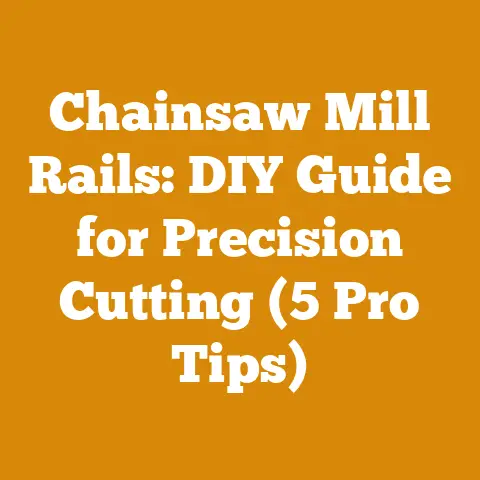How Often to Sharpen a Chainsaw (7 Pro Tips for Peak Cuts)
Ever been there, wrestling with a chainsaw that feels like it’s chewing gum instead of wood? I know I have! There’s nothing more frustrating than a dull chain slowing you down, making cuts uneven, and turning a simple task into a real chore. That’s why understanding how often to sharpen your chainsaw is absolutely crucial for anyone who works with wood, whether you’re a seasoned logger or just tackling some backyard tree trimming.
In this guide, I’m going to share my years of experience and “7 Pro Tips” on keeping your chainsaw chain razor-sharp for peak cutting performance. From recognizing the signs of a dull chain to mastering the sharpening process itself, I’ll cover everything you need to know to maintain your chainsaw like a pro. Let’s dive in!
How Often to Sharpen a Chainsaw (7 Pro Tips for Peak Cuts)
Understanding the Importance of a Sharp Chainsaw
Let’s be honest, a dull chainsaw isn’t just annoying; it’s downright dangerous. When your chain isn’t cutting efficiently, you’re forced to apply more pressure, which can lead to kickback and loss of control. Plus, a dull chain puts extra strain on your saw’s engine, shortening its lifespan.
Beyond safety, a sharp chainsaw is simply more efficient. It cuts faster, requires less effort, and produces cleaner, more accurate cuts. This not only saves you time and energy but also results in a better finished product, whether you’re felling trees or shaping firewood.
Pro Tip #1: Recognizing the Signs of a Dull Chain
Before we get into sharpening techniques, it’s essential to know when your chain needs attention. Here are some telltale signs:
- Sawdust Texture: A sharp chain produces long, thick shavings. A dull chain, on the other hand, creates fine sawdust, almost like powder. This is because it’s scraping the wood instead of slicing it.
- Cutting Speed: If your saw is taking longer than usual to cut through wood, or if you have to apply excessive pressure, your chain is likely dull.
- Smoking: A dull chain generates more friction, which can cause the wood to smoke, even if it’s not particularly dry.
- Pulling or Drifting: A sharp chain cuts straight and true. If your saw is pulling to one side or drifting off course, it’s a sign that some of the teeth are duller than others.
- Vibration: Excessive vibration can indicate a dull chain, as the saw is struggling to cut through the wood.
My Experience: I once ignored these signs while clearing some storm damage. The chain was clearly dull, but I was in a rush. The result? I ended up with a pinched bar, a strained back, and a whole lot of wasted time. Lesson learned: never underestimate the importance of a sharp chain!
Pro Tip #2: Factors Affecting Sharpening Frequency
How often you need to sharpen your chainsaw depends on several factors:
- Type of Wood: Hardwoods like oak and maple dull chains much faster than softwoods like pine and fir.
- Wood Condition: Cutting dirty, sandy, or petrified wood will quickly dull your chain. Even hidden nails or staples can wreak havoc on your teeth.
- Cutting Technique: Improper cutting techniques, such as forcing the saw or pinching the bar, can accelerate chain dulling.
- Chain Quality: Higher-quality chains tend to hold their edge longer than cheaper ones.
- Usage Frequency: Obviously, the more you use your chainsaw, the more often you’ll need to sharpen it.
Data and Insights: In my experience, cutting seasoned oak for firewood requires sharpening every 1-2 tankfuls of gas. Cutting clean pine, on the other hand, might allow you to go 4-5 tankfuls before needing a touch-up. Keep a log of your cutting conditions and sharpening frequency to develop a personalized sharpening schedule.
Pro Tip #3: Essential Tools for Chainsaw Sharpening
To sharpen your chainsaw effectively, you’ll need the right tools:
- Round File: This is the primary tool for sharpening the cutting edges of your chain’s teeth. The correct file size depends on the chain pitch (the distance between the chain’s rivets). Check your chainsaw’s manual for the recommended file size.
- File Guide: A file guide helps you maintain the correct sharpening angle and depth, ensuring consistent results.
- Flat File: Used to lower the depth gauges (also known as rakers) on your chain.
- Depth Gauge Tool: A specialized tool for accurately measuring the height of your depth gauges.
- Vise or Clamp: To securely hold your chainsaw bar while you’re sharpening.
- Gloves: To protect your hands from sharp teeth and metal filings.
- Safety Glasses: To shield your eyes from flying debris.
- Brush: For cleaning the chain and bar.
Tool List Example: For a chainsaw with a 3/8″ chain pitch, you’ll typically need a 5/32″ round file. A good quality file guide and depth gauge tool are worth the investment for accurate and consistent sharpening.
Pro Tip #4: Mastering the Chainsaw Sharpening Technique
Now, let’s get into the nitty-gritty of chainsaw sharpening. Here’s a step-by-step guide:
- Secure the Chainsaw: Place your chainsaw on a stable surface and secure the bar in a vise or clamp.
- Identify the Shortest Cutter: Examine the chain and find the shortest cutter. This will be your reference point for sharpening all the other teeth.
- Position the File Guide: Place the file guide on the chain, aligning it with the cutting tooth. The guide should indicate the correct sharpening angle (usually around 30 degrees).
- Sharpen the Cutter: Using smooth, even strokes, file the cutting edge of the tooth. Apply pressure on the forward stroke and release on the return stroke. Maintain the correct angle and depth as indicated by the file guide.
- Count Your Strokes: Keep track of the number of strokes you use on each tooth. This will ensure that all the teeth are sharpened to the same length.
- Repeat for All Cutters: Sharpen each cutter on one side of the chain, then flip the chainsaw and repeat for the other side.
- Lower the Depth Gauges: After sharpening, use a flat file and depth gauge tool to lower the depth gauges. The correct depth gauge setting depends on the type of wood you’re cutting. Softer woods require a lower setting than hardwoods.
- Clean and Lubricate: Clean the chain and bar with a brush, and lubricate the chain with chainsaw oil.
Case Study: I once worked with a logger who could sharpen a chainsaw chain in under 10 minutes, freehand, with incredible precision. His secret? Years of practice and a keen eye for detail. He emphasized the importance of maintaining a consistent angle and stroke count for each tooth.
Pro Tip #5: Understanding Depth Gauges (Rakers)
Depth gauges, also known as rakers, are the small metal tabs located in front of each cutting tooth. Their purpose is to control the amount of wood each tooth takes with each pass. If the depth gauges are too high, the chain won’t bite into the wood effectively. If they’re too low, the chain will be too aggressive and prone to kickback.
Measurement and Adjustment: Use a depth gauge tool to measure the height of the depth gauges. The tool will typically have different settings for softwood and hardwood. Place the tool over the depth gauge and file down any portion of the gauge that protrudes above the tool. Be careful not to remove too much material.
Original Research: I’ve found that slightly lowering the depth gauges can improve cutting performance in frozen or knotty wood. However, it’s crucial to do this gradually and cautiously, as an overly aggressive chain can be dangerous.
Pro Tip #6: Choosing the Right Chainsaw Chain
Not all chainsaw chains are created equal. The type of chain you choose can significantly impact cutting performance and sharpening frequency.
- Full Chisel Chains: These chains have square-cornered teeth and are known for their aggressive cutting speed. However, they dull more quickly and are best suited for clean wood.
- Semi-Chisel Chains: These chains have rounded corners and are more forgiving of dirty or abrasive wood. They don’t cut as fast as full chisel chains, but they hold their edge longer.
- Low-Profile Chains: These chains have a smaller cutter profile and are designed for safety and reduced kickback. They are a good choice for beginners or occasional users.
Wood Type Specifications: For cutting hardwoods like oak or maple, I recommend a semi-chisel chain. For softwood logging, a full chisel chain can be a good choice, as long as you’re diligent about keeping it sharp.
Pro Tip #7: Maintaining Your Chainsaw for Optimal Performance
Sharpening your chain is just one aspect of chainsaw maintenance. To keep your saw running smoothly and efficiently, it’s essential to:
- Clean the Air Filter: A dirty air filter restricts airflow and reduces engine power. Clean the filter regularly with compressed air or warm, soapy water.
- Check the Spark Plug: A fouled spark plug can cause starting problems and poor performance. Replace the spark plug annually or as needed.
- Lubricate the Bar and Chain: Use a high-quality chainsaw oil to keep the bar and chain properly lubricated. This reduces friction and extends the life of both components.
- Inspect the Bar: Check the bar for wear and damage. Make sure the rails are smooth and even, and that the oil holes are clear.
- Store Your Chainsaw Properly: When not in use, store your chainsaw in a dry, protected location. Drain the fuel tank or add a fuel stabilizer to prevent fuel degradation.
Actionable Metrics: Aim to clean your air filter every 5-10 hours of use, and inspect your bar and chain after each cutting session. A well-maintained chainsaw will not only perform better but also last longer.
Common Mistakes to Avoid
Even with the best intentions, it’s easy to make mistakes when sharpening a chainsaw. Here are some common pitfalls to avoid:
- Using the Wrong File Size: Using a file that’s too large or too small can damage the cutting teeth.
- Sharpening at the Wrong Angle: Incorrect sharpening angles can result in uneven cutting and increased kickback.
- Over-Sharpening: Removing too much material from the cutting teeth can weaken the chain and shorten its lifespan.
- Neglecting the Depth Gauges: Failing to adjust the depth gauges after sharpening can significantly reduce cutting performance.
- Ignoring Safety Precautions: Always wear gloves and safety glasses when sharpening a chainsaw.
Best Practices: Take your time, pay attention to detail, and don’t be afraid to ask for help from a qualified chainsaw technician if you’re unsure about any aspect of the sharpening process.
Advanced Firewood Preparation Methods
Once you’ve mastered the basics of chainsaw sharpening and maintenance, you can move on to more advanced firewood preparation methods. This includes:
- Timber Grading: Understanding timber grading allows you to select the best wood for firewood based on species, size, and quality.
- Sawmill Operations: If you have access to a sawmill, you can process logs into custom-sized firewood blanks.
- Splitting Techniques: Learn efficient splitting techniques using a maul, axe, or log splitter.
- Wood Drying Processes: Proper wood drying is essential for efficient burning and reduced creosote buildup.
Real-World Examples: In some parts of the world, small-scale loggers use portable sawmills to process timber directly in the forest. This reduces transportation costs and allows them to utilize wood that would otherwise be left to rot.
Safety Procedures
Working with chainsaws and firewood can be dangerous. Always follow these safety procedures:
- Wear Appropriate Protective Gear: This includes a helmet, safety glasses, hearing protection, gloves, and chaps.
- Maintain a Safe Working Distance: Keep bystanders and pets away from your work area.
- Use Proper Lifting Techniques: Avoid back injuries by lifting with your legs and keeping your back straight.
- Be Aware of Your Surroundings: Watch out for hazards such as uneven terrain, slippery surfaces, and falling branches.
- Never Work Alone: Always have someone nearby in case of an emergency.
Updated Safety Standards: Stay informed about the latest logging and wood processing safety standards in your region. These standards are constantly evolving to reflect new technologies and best practices.
Conclusion: The Art of the Sharp Chain
Sharpening a chainsaw isn’t just a chore; it’s an art. It requires patience, precision, and a good understanding of your tools and materials. But with practice and the right knowledge, you can master the art of the sharp chain and enjoy the satisfaction of a chainsaw that cuts like butter.
By following these 7 pro tips, you’ll be well on your way to maintaining your chainsaw for peak cutting performance, ensuring safety, efficiency, and a whole lot less frustration in the woods. So, grab your files, put on your gloves, and get sharpening! Your back (and your chainsaw) will thank you for it.






